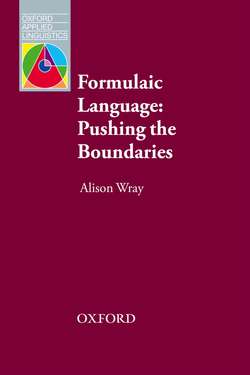Читать книгу Formulaic Language - Alison Wray - Страница 8
На сайте Литреса книга снята с продажи.
PART ONE
Determining boundaries
2
Conceptualizing formulaic language
Introduction
ОглавлениеThis chapter sets the scene for the exploration of the boundaries of formulaic language. Since boundaries are defined relative to a central ground, the main task is to lay out that ground. First, some observations about the nature of formulaicity are offered, as a means of introducing illustrative examples and demonstrating some of the typical linguistic features associated with it. Next, a theoretically-grounded definition of formulaicity is given. This definition reflects the conclusions drawn from the lengthy evaluation of evidence for various types of formulaic language undertaken in Wray (2002b).
Third, three key conceptual claims about the nature of formulaic language are presented. Each conceptual claim captures a different aspect of the theory developed in Wray (2002b).2 Inevitably one cannot, in a brief digest, re-present all the arguments and considerations that led to those conclusions, and the interested reader is urged to follow up on the references provided, to see why a particular view was taken. The first claim is that the mental lexicon is heteromorphic. This is an observation about how we process formulaic language. The second is that the content of the lexicon is determined through ‘Needs Only Anaslysis’, and it relates to how we learn formulaic language. The third claim, that morpheme equivalent units enable the speaker to manipulate the hearer, addresses the question of what we use formulaic language for.
2
A fourth conclusion, that access to the lexicon is distributed across the brain (Wray 2002b: Chapter 14), is less central to this book and so is not used as an anchoring conceptual claim here. It is, however, mentioned later, as it becomes relevant in specific discussions.
